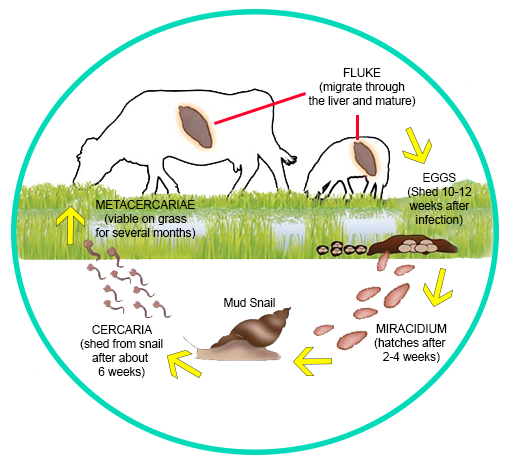The NADIS Liver Fluke forecast uses veterinary surveillance combined with weather reports to predict the risk of disease over the coming months. ‘There was an increase in diagnoses of liver fluke disease at the start of this year and the risk of acute fluke is forecast to be high in some parts of North West England and North Wales. It is therefore likely, that treatment for acute fluke will be necessary during October on farms in these regions, especially where there is a history of liver fluke disease.’
Fasciolosis is a common parasitic disease of both cattle and sheep in the UK, caused by Fasciola hepatica and is estimated to cost the cattle industry £23 million annually.
In cattle, infection is more commonly encountered in beef cows grazing poor wet pasture but disease can be seen in dairy cattle especially after summering cattle, most likely bulling heifers, away from home on infested pastures.

Life cycle
The life cycle involves a snail host whose activity and availability require adequate moisture and a suitable ambient temperature during the summer months. Recent wet summers (2015) have been ideal for this complicated fluke lifecycle by supporting large numbers of snails in wet habitats. Cerceriae are released from snails between August and October which develop- into the infective metacercariae, which can survive on pasture for several months to infect grazing cattle.
Clinical Signs
Dairy Cows – In severe chronic infestations, dairy cows show reduced milk yields and poor fertility together with excessive weight loss. Many show chronic diarrhoea.
Beef Cows – The clinical signs are similar to those encountered in dairy cows but can be especially severe in spring-calving beef cows where liver fluke exacerbates the metabolic demands of advanced pregnancy in cattle on marginal winter rations. This results in the birth of weakly calves to cows with little milk, causing high perinatal losses. Severely affected cows may become debilitated with an increased incidence of metabolic and infectious diseases at calving.
Twin-bearing cows show the most severe signs due to the high demands of two foetuses. Unlike infestation in sheep, peripheral oedema is a less common finding with chronic fasciolosis in cattle. Severe infections may cause anaemia.
Bulls – Infested bulls show similar clinical signs as cows such as chronic weight loss and diarrhoea.
Fattening cattle – UK slaughter plants are reporting increasing numbers of liver condemnations due to fluke damage in 12 to 18 month-old fattening cattle where reduced live-weight gains were not suspected by producers presumably due to low-moderate infestation levels.
Sheep
Signs of acute fluke disease
- Sheep with acute fluke infestation may simply be found dead without prior signs of illness therefore it is important to have all sudden deaths investigated to allow immediate preventive measures.
- Post-mortem examination is essential to establish a diagnosis of acute fluke.
- Less severe clinical signs include reduced grazing, rapid weight loss, weakness, abdominal pain, anaemia, and slow to gather.
Differential Diagnoses
Weight loss and chronic diarrhoea in individual cattle will also be investigated by your veterinary surgeon for paratuberculosis and salmonellosis. Chronic liver fluke and paratuberculosis have been reported in the same animal. Other causes of chronic weight loss in adult beef cows could include other bacterial causes such as pyelonephritis, vegetative endocarditis, chronic mastitis, and chronic suppurative pneumonia.
Inadequate nutrition generally presents as a whole group/herd problem of poor production and weight loss during the late winter months in beef herds with diarrhoea an uncommon finding unless poor quality silage is fed.
Fluke Control Measures
- Liver fluke disease can be largely controlled by effective drugs administered at the correct time as part of the flock health plan.
- Wherever possible, reduce the risk of fluke infection by keeping sheep away from potentially contaminated, poorly-drained areas of the farm.
- Triclabendazole (TCBZ) is the drug of choice in cases of acute fluke disease because it is effective against very young immature fluke stages.
- However, advice will also be needed where TCBZ-resistance has been previously suspected on farms and the effectiveness of fluke treatments monitored.
- The coproantigen ELISA test can be used to monitor TCBZ efficacy two to three weeks after dosing, and farmers should contact their veterinary surgeon for further advice where drug resistance is suspected.
- Later fluke treatments could use closantel or nitroxynil especially if TCBZ- resistance is suspected or proven on the farm.
- Where these drugs are used then accurate dosing is essential as toxicity is possible.
- Also, ensure all lambs are vaccinated against clostridial diseases because migrating flukes predispose to Black disease.
If you’re concerned about Liver Fluke and would like more information, feel free to contact us.
